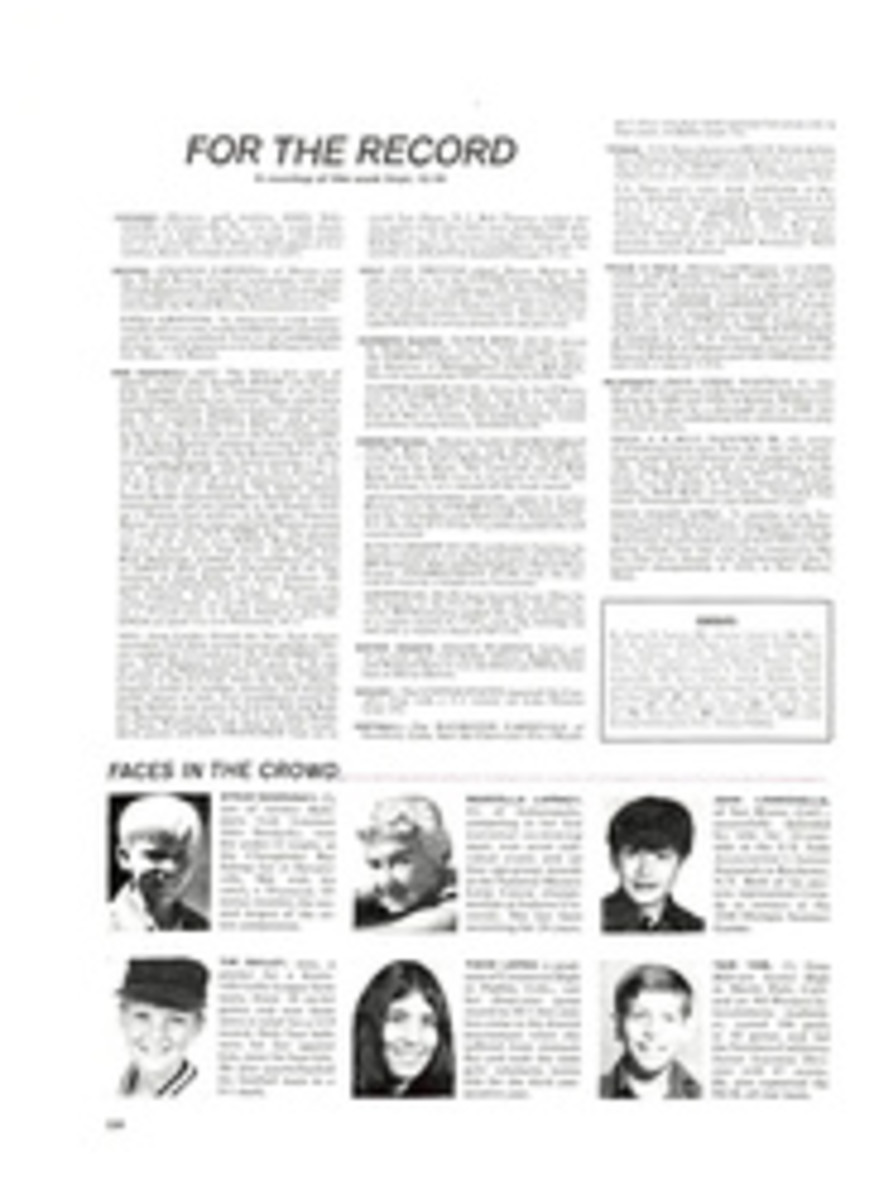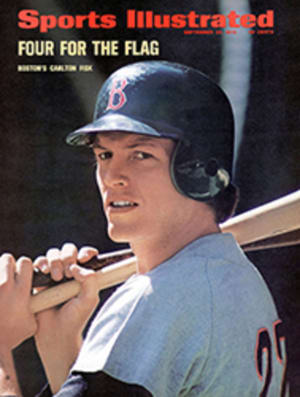
WINNING WITH A DASH OF ORANGE
They came down out of the East, espousing crazy notions. "I consider football just another extracurricular activity, like debating, the band, or anything else on campus," said their coach, Joe Paterno. "It should never be taken out of context."
"Well," said a Tennessee supporter. He had on an orange shirt and hat. His wife had on an orange dress and was carrying an orange purse. His little boy had on an orange hat, shirt and bow tie. They were on their way into Neyland Stadium, and they were surrounded by enough orange shirts, hats, purses, dresses, ties and trousers to subdue the Irish Republican Army. If you could pan out and get a broad view of the whole city of Knoxville, also known as Big Orange Country, you could see that every third physical object was colored orange or had an orange, or the word "orange" printed or pasted or laminated or appliquéd on it. The Tennessee man was asked to comment on the Penn State coach's remark.
"Well," he said. "We can beat their band, too."
It was what is called an intersectional collision. The husky, cultivated (they once had a pianist defensive tackle), everything-in-proportion Nittany Lions, ranked either sixth or seventh according to which poll you believe, versus the rangy, hard-pursuing, fully emphasized Volunteers (known as the Big Orange), ranked seventh or sixth.
It was also—not just incidentally—the first night home game in Tennessee's history, and it was a chance for Penn State to avenge its one loss of last year, a 31-11 defeat in its final game in the very same stadium. Furthermore, it was this season's first chance to find out whether Easterners—or at least their football—are effete or not. Some hours later, when the 384 new $65 light bulbs were blinking off and that orange crowd of 71,647, the largest ever to attend a sports event in the state, was filing out, Penn State was still seeking revenge but the consensus seemed to be that any team that could lose only 28-21 to Tennessee at home couldn't be all bad.
In fact, had it not been for two very fleet young Vols, Penn State might have won in a walk. In the first half the Tennessee defense performed the way it had last year, intercepting two passes and recovering two fumbles—only this year, instead of scoring the points itself via runbacks, the defense turned the attack over to the offense, led by Quarterback Condredge Holloway and Tailback Haskell (Snap Back) Stanback.
The diminutive Holloway (he looks closer to 5'9", 160 than the 5'11", 175 he is purported to be) fluttered in and out of rushers' grasps like a butterfly, completed key passes and kept a complicated, shifting, all-kinds-of-people-in-motion offense flowing up and down the field. The lean 200-pound Stanback scored on runs of 41 and two yards. An ordinarily less spectacular Vol, Fullback Steve Chancey, not only threw the big block on Stanback's 41-yarder but also went 22 yards through a jungle of shoulders and arms for a touchdown of his own. The result was a halftime score of 21-0.
That seemed a little excessive at the time, but all those points came in handy during the second half when the Tennessee pass defense not only ceased to create turnovers but became downright porous, which in terms of Tennessee tradition is like the Distant Early Warning Line becoming dotted. Penn State Quarterback John Hufnagel had looked shaky in the first half while passing for 21 yards. But in the second he threw for 171 yards and two touchdowns, and he handed off for a third.
Meanwhile the Penn State linebackers, instead of trying to adjust to every whim of the Tennessee shifts, had just dug in and started knocking down everyone who came to hand. As a result, the Vols ceased to move the ball.
This would have been normal enough last year, when the function of the Tennessee offense was to stay out of trouble until Bobby Majors or some other defensive back could pluck some form of loose ball from the air and score with it. But in this year's opener, a 34-3 victory over Georgia Tech, the Tennessee offense actually sustained drives. Some of that sustenance was what the Vol offense needed in the second half against Penn State.
Needed and produced. Seconds after the fourth quarter began, Tennessee, now leading only 21-14, took over at its own 20. Six minutes and 13 plays later Stanback went over from the two for his third touchdown. Even though Hufnagel brought the Lions right back to make it 28-21, time ran out on them before they could score again.
Ah, ball control. Everyone knows how vital it is. But in the abstract it seems a little boring, just as, in the abstract, there is nothing very spicy about "the little leadership-type course thing" Head Coach Bill Battle gave the Vols every Monday night last winter.
"I believe that leaders are made not born," says Battle. "Sometimes you do have natural leaders—you've got a leadership element on your team. If they lead in the direction you want to go, you're in business. If they lead in another direction, you're in trouble. So I prepared a lesson every week, and gave 'em little handouts—motivational things, positive-thinking things. We talked about leaders who succeeded after failing many times—Lincoln, and, of course, Nixon." Battle himself is no authority on even prefatory failure. At the age of 30 he is in his third year as a head coach and he has not finished out of the top 10.
Tennessee has played big for Battle, but its size has been strangely small. When asked why he has tended to have relatively little players, Battle says, "We've recruited big ones, but some of the big ones haven't played as well as the small ones. Maybe we just haven't gotten the right big ones."
Holloway continues the trend—brilliantly. In spite of his stature, he was athlete enough to be able to dunk a basketball at 14. At 17 he was sought out by the Montreal Expos, who offered him close to $100,000 to become their shortstop someday. But his mother insisted that he go to college first. "A lot of people in baseball could use some schooling on a human relations basis," says Mrs. Holloway. "They couldn't or wouldn't talk to me. They would go through his coach, and it reminded me of some old stereotype that you must go through a white to communicate with a black because a black doesn't know how to talk or something. The university [Tennessee] didn't deal this way."
As a freshman last year Holloway walked on campus and beat Majors, the dorm champion, at Ping-Pong. Scrimmaging against the varsity before its last season game with Auburn he would run one series of downs as Pat Sullivan and the next as Terry Beasley—thus performing as both ends of that famed pass-catch team. Playing against the Notre Dame freshmen he dived into the air from their seven, was hit at thigh level by two tacklers on the five, did a flip and landed on his back in the end zone.
Now, at 19, he has shown his nerve by growing a mustache—the rule evidently having been relaxed in the year and a half since NCAA champion Bill Skinner was prevented from throwing the javelin for Tennessee because of his face hair. Battle admires the fact that Holloway "shows no fear. He gives total commitment of his body. You have to cringe every time the little son of a gun gets around a crowd." Holloway was around a crowd of tacklers all night against Penn State, and although the crowd tended to approach him in a gingerly fashion, lest he wrinkle and be gone, the crowd also jumped on him a good many times.
One time when it seemed as if the crowd had him, Holloway produced the biggest move of the night. It was the next to last play of the 80-yard drive. He had accounted for most of the drive's yardage himself, having completed four of four passes for 45 yards and run three times for 20. On second and goal from the Penn State nine he rolled out on the option and was hit a few times. And then two people had their arms wrapped around him at once, and he mostly faded from view. He seemed down, and somebody in the press box said, "Well, no gain on that..." and then he pitched out, to Stanback, who picked up seven yards. On the next play Stanback scored the clincher.
One might well wonder why last year's and this year's games between these two teams both happened to take place in Knoxville. It is very complicated, but at one point Paterno, wanting to have the second game played at Penn State on television, told the Volunteers he would not play in Knoxville at this time of year except at night, knowing that Tennessee had no lights in Neyland Stadium. So they put up lights. Paterno might have guessed he was a beaten man already.
PHOTO
Airborne, Holloway shifts thisaway after an unfortunate State defender leaned thataway.

